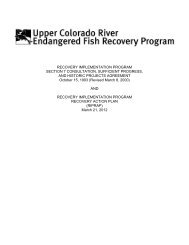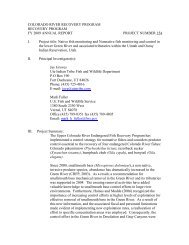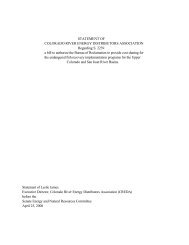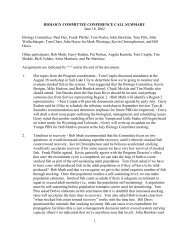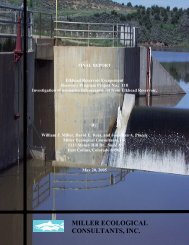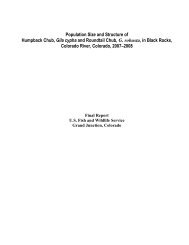K. R. Bestgen, K. A. Zelasko, and G. C. White. Monitoring ...
K. R. Bestgen, K. A. Zelasko, and G. C. White. Monitoring ...
K. R. Bestgen, K. A. Zelasko, and G. C. White. Monitoring ...
You also want an ePaper? Increase the reach of your titles
YUMPU automatically turns print PDFs into web optimized ePapers that Google loves.
that simulate Green River backwaters, which could be used to determine attraction distances at<br />
even greater lengths than are possible with relatively short <strong>and</strong> restricted troughs.<br />
A field test of attraction <strong>and</strong> capture efficiency of razorback sucker larvae would follow.<br />
This second experiment would be relatively easy to accomplish if a hatchery could provide<br />
relatively small quantities of larvae for marking, as has been done in prior experiments (Hedrick<br />
et al. 2009), <strong>and</strong> would inform aspects of sampling effort <strong>and</strong> spatial coverage in a natural setting<br />
to accurately monitor larvae presence with an appropriate level of effort. The assessment would<br />
proceed in two parts. First, we recommend assessing capture efficiency of larvae released within<br />
backwaters sampled with st<strong>and</strong>ard light trap gear. We propose a staged release of batches of<br />
larvae over a three-day period. On the first day, a small number of tetracycline-marked larvae (n<br />
= 10?) would be released in the morning, with subsequent light trap sampling in the evening <strong>and</strong><br />
overnight. Traps would be emptied the following day, <strong>and</strong> a larger number of similarly marked<br />
larvae would be released (n = 100), followed by subsequent sampling. The final day would use a<br />
larger batch of released larvae (n = 500) followed by similar sampling effort. Such an effort,<br />
completed in 4-6 different backwaters, with similar-age fish but different backwater size, would<br />
allow for estimation of sampling detection probabilities by trap (each trap as a sampling unit)<br />
<strong>and</strong> by backwater night (traps combined) over a range of habitat types, <strong>and</strong> importantly, would<br />
allow for estimation of density effects of larvae <strong>and</strong> backwater size on capture success.<br />
The st<strong>and</strong>ard number of traps set in a backwater typically depends on backwater size,<br />
with up to 5–10 traps set in each. Traps are set far enough apart such that the halo of light from<br />
each does not overlap with others. In large backwaters, larvae <strong>and</strong> traps would be placed in<br />
about the same proximity. A main complication would be availability of similarly aged fish over<br />
a long enough period to complete the experiments, because the number of light traps available is<br />
limited enough to not allow for simultaneous sampling in 4–6 backwaters. Sampling could occur<br />
prior to known wild razorback sucker larvae occurrence, which may negate the need to use<br />
marked fish, but use of unmarked fish is not a preferred technique. Sampling before presence of<br />
wild fish would not then interfere with or dilute other sampling efforts, <strong>and</strong> is possible because<br />
hatchery-produced larvae are typically available before wild larvae are present.<br />
A third complementary experiment conducted simultaneously would be to release<br />
relatively small batches of larvae that are differently marked (e.g., single <strong>and</strong> doubletetracycline-marked<br />
larvae, [n = 25,000–50,000]) into the Green River at or near spawning areas<br />
to further test dispersal times to backwaters. Some tests of this were conducted during the<br />
20




